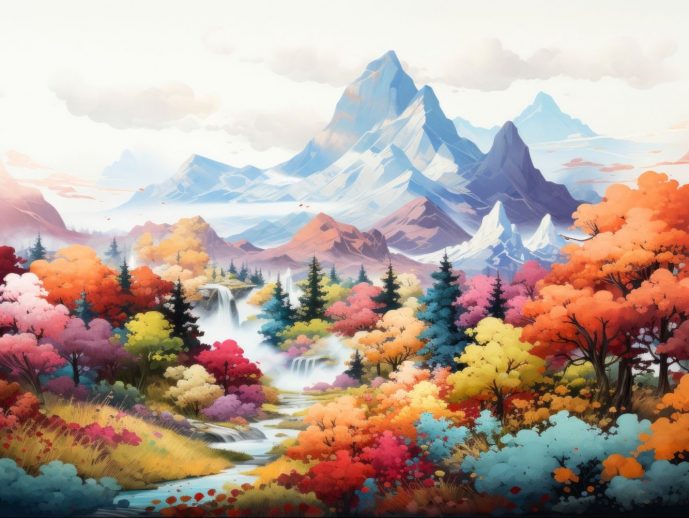Categories more
- Adventures (17)
- Arts / Collectables (15)
- Automotive (37)
- Aviation (11)
- Bath, Body, & Health (77)
- Children (6)
- Cigars / Spirits (32)
- Cuisine (16)
- Design/Architecture (23)
- Electronics (13)
- Entertainment (4)
- Event Planning (5)
- Fashion (45)
- Finance (9)
- Gifts / Misc (6)
- Home Decor (44)
- Jewelry (41)
- Pets (3)
- Philanthropy (1)
- Real Estate (15)
- Services (23)
- Sports / Golf (14)
- Vacation / Travel (60)
- Watches / Pens (14)
- Wines / Vines (24)
- Yachting / Boating (17)
How Landscape Paintings Reflect The Artist’s Inner World
Published
07/16/2025Did you ever stand before a landscape painting and feel that it was whispering to you, as it contained a secret, a mood, or even a non-specific memory, but completely familiar? You’re not alone.
What on the surface looks to be a serene countryside, a torrent coast, or a Valley of the Sun frequently contains much more than simple visual loveliness.
It can grasp what the artist on the other side of the canvas is feeling, thinking, and experiencing. That’s where the external and internal worlds meet, and what you see is scenery plus something greater than scenery—it’s a whispered dialogue.
In this article, you’ll discover how artists channel their feelings, experiences, and philosophies into the landscapes they create and why these works often reveal more about the creator than meets the eye.
Continue reading to delve into the deeper aspects of landscape paintings and the human spirit that inspires them.
1. Landscape Paintings as Emotional Mirrors

A landscape is never a landscape. Behind each hill, river, or stand of forest, an artist can instill a range of emotions—happiness, wistfulness, sadness, even irritation.
When artists paint nature, they don’t merely document what they see; they interpret it through the lens of their current emotional state. Landscape paintings will likely serve as emotional mirrors, translating inner feelings onto an external scene.
For instance, a sunset in resplendent oranges and gentle purples can evoke tranquility or optimism, while a dark wood in somber greens and greys can impart mystery or gloominess. This emotional translation provides the viewer with an opportunity to empathize on a deeper level. Regardless of whether the scene is familiar, the feeling it evokes can be accessed universally.
Artists employ techniques such as color, brushstroke intensity, and composition to express their emotions, making every painting a visual journal. That’s what makes every landscape uniquely powerful—it captures both place and psyche.
2. Escapism and the Desire for Inner Peace

In times of stress, artists often turn to landscapes as a form of escape, a way to mentally and emotionally remove themselves from chaos or grief.
Creating a quiet meadow, set against a serene mountain range or a peaceful lake, can be a form of meditation. These give the viewer the same effect: a journey or reprieve, a visual or emotional vacation. So, in a way, these paintings are safe zones, created one brushstroke at a time.
This desire for peace lies deep in the human soul.
Artists transfer it into their creative process, not necessarily as a means of adjusting to a disturbing, external situation, but as a means of striving toward something agreeable, comforting, or harmonious. This quest may become more pronounced, particularly when there is personal or social upheaval.
In this context, landscape painting transcends the physical landscape as a devotion to a desire for clarity and tranquility —a catharsis that provides the artist and viewer an escape from reality, albeit even momentarily.
3. Nature as a Symbolic Language
Through nature’s components, such as trees, clouds, and mountains, artists often infuse unique meaning into art. A single tree standing in a large open field can mean self-reliance, isolation, or even resilience. Similarly, a curvy path can represent life’s journey full of untapped potential and uncertainty. In this way, landscapes go beyond literal representation to act as a coded language of the soul. These choices are rarely accidental.
Symbolism enables artists to convey their stories through various artistic forms. The viewer may not always grasp the intended meaning, but the symbolism often resonates subconsciously.
The time of day can also convey rich meaning. For instance, depicting a dawn scene can symbolize new beginnings, and dusk can symbolize closure or retrospection. It’s this blend of visual storytelling and psychological depth that gives landscapes their timeless appeal.
4. Memory and Personal History in the Landscape
Throughout one’s life, memories and places frequently intertwine. These may include fleeting visits to a calm beach, quiet forests once trudged through, and small farms visited as children.
Such places evoke strong emotional attachments associated with them. This emotional bond profoundly changes perspective, and by recreating these meaningful areas, artists get to preserve fragments of their history, encapsulating the moments that shaped their development. The end result is deeper than mere setting; it is biography in visual form.
These landscapes, embedded with memories, are enhanced by specific attributes such as recognizable colors, light quality, and repeating landmarks, which hint at the landscape’s true significance.
Regardless of a viewer’s familiarity with the recollection, they tend to feel the emotions attached to it. This strategy shifts the landscape into a vessel of identity where the physical place becomes irrelevant and the sentiment it conjures up becomes everything.
Every painting captures the sentiment, serving as a gateway and a bridge that entwines the past and present, the artist and the observer, memory and recollection, intertwined seamlessly.
5. Inner Conflict Expressed Through Nature’s Drama
Not all landscapes are peaceful. Stormy skies, jagged cliffs, and turbulent waters can mean inner conflict or emotional turmoil. In these scenes, nature becomes a drama stage for the artist’s turmoil, where emotions can erupt visually in a raw and poetic way. The chaos of a windswept seascape or the tension in a darkening sky often mirrors the inner battles the artist is fighting.
This connection between nature’s volatility and human emotion has been around for a long time. Romantic era painters used dramatic natural elements to explore loneliness, fear and existential dread.
Modern artists still use similar techniques to express anxiety, frustration or uncertainty. These works don’t soothe; they stir. They make you feel uncomfortable and confront your emotions. In this way, even the most turbulent landscape can be an act of honesty—a release, a confession or a cry for help.
Conclusion
When you observe a landscape you are not merely looking at scenery, you are peeping into someone else world.
These painted landscapes, serene or rugged, are meant to evoke emotion, pondering and identification.
So, next time you are in front of a landscape, listen. It could be telling your story as well.















